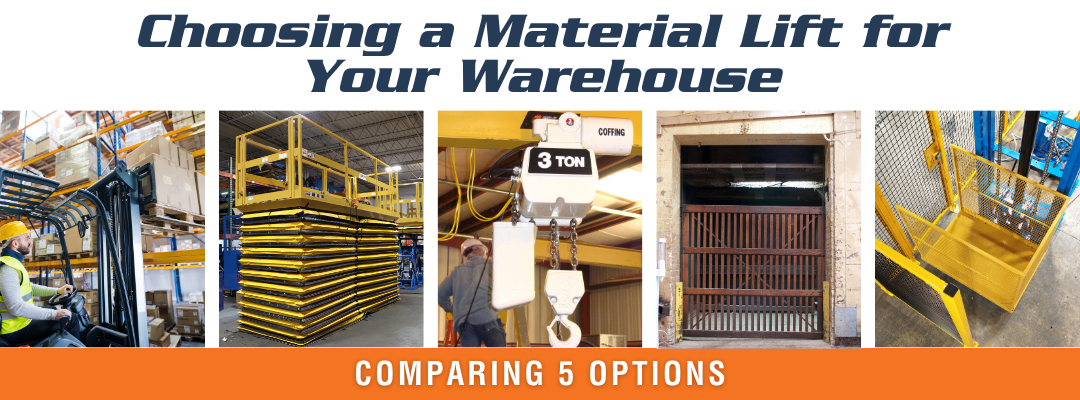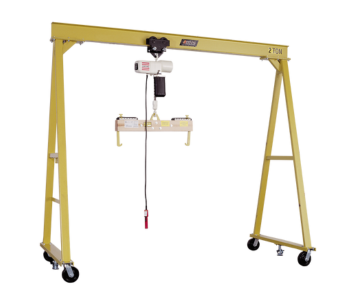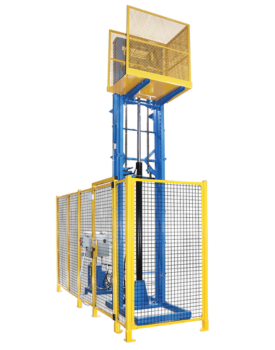We use cookies to make your experience better. To comply with the new e-Privacy directive, we need to ask for your consent to set the cookies. Learn more.
Choosing a Material Lift for Your Warehouse: Comparing 5 Options

Multi-level warehouses need material handling equipment (MHE) designed for the job. But choosing material lifts isn’t always straightforward — you’ll need to think about the average size of loads, the variety of materials, and the layout of your operation in order to find an efficient solution. You’ll also need to consider costs, including long-term maintenance, to get the best possible return on investment.
In many instances, warehouses need a variety of types of lifts to handle routine work while maximizing throughput. The good news for buyers: The most common lift options have clear advantages and disadvantages, and understanding their features can help you make a case-appropriate decision.
5 Material Handling Lift Options for Warehouses
Before evaluating your options, it’s helpful to ask a few questions.
- How much do you need to lift? Build in overages for capacity estimates to ensure that your vertical lift will be able to handle unconventional loads.
- What are the physical dimensions of the loads? Measure both the smallest and largest prospective loads.
- How high do you need to lift materials? Measure the total distance from floor to floor, along with clearances.
- What access do you need to materials on lower and higher floors? You’ll need a lift with a loading/unloading pattern that makes sense for your facility.
- Do workers need to travel with the load? This will determine whether you truly need a freight elevator or an aerial work platform (discussed in detail below).
Of course, these are easier questions to ask (and answer) when you’re planning new construction. If your operation has specific features or layout considerations (floor openings, pre-existing shaft-ways, and so on), keep those in mind while reading through the rest of this article.
With those considerations in mind, let’s look at five of the most popular options for vertical material lifts in warehouses and storage centers.
1. Forklifts: Versatile Material Lifts with Major Limitations
Using a forklift for vertical lifts makes sense; you’ve already got lift trucks on the floor, and they’re certainly capable of handling larger loads.
But while forklift trucks are versatile, that versatility isn’t always an asset. Vertical lift applications must meet OSHA’s 1910.178 requirements, along with any state-specific safety standards.
The simple fact is that fixed travel lanes are much safer — and much more efficient. Without fixed lanes, forklift operators must maneuver around pedestrians, and even with experienced operators, dropped loads (and lost product) can occur.
Additionally, many warehouses have multiple levels of mezzanines or additional floors — not just one. Multi-level storage may take forklifts out of consideration.
2. Scissor Lifts: A Material Lift and Aerial Work Platform
Scissor lifts can be a practical option for the vertical handling of materials and workers. They’re not ideal when you’re primarily moving materials alone, or when you’re moving materials on a regular basis — but as work platforms, scissor lifts are difficult to beat. 
A well-engineered scissor lift provides several major advantages:
- Precise lifts with extraordinary load capacities.
- A safe aerial work surface and means of transporting workers between floors.
- Excellent support for physically large loads and materials with unconventional dimensions.
- Greater versatility than freight elevators (discussed below).
When working on scissor lifts, workers must follow OSHA’s requirements for scaffolds. As we’ve discussed in other articles, OSHA considers scissor lifts to be scaffolds, not aerial lifts, since most scissor lifts are fixed in position. To learn more, read: OSHA Standards for Scissor Lift Safety in Elevating Work Platforms.
Products to Consider: BHS Aerial Work Platform
BHS provides the Aerial Work Platform (AWP), a custom-built solution with closed hydraulic circuits, hardened chrome piston rods, and honed cylinders for reliable performance.
The AWP provides a safe, powerful alternative to traditional scaffolding, with railings to protect workers and full compliance with OSHA and ANSI MH29.1 (Safety Requirements for Industrial Scissor Lifts.).
3. Gantry Cranes: Cost-Effective Lifts for Heavy-Duty Materials
Gantry cranes work well as vertical material lifts, particularly when working with heavy tools, engines, batteries, or other weighty materials with unconventional sizes. 
Gantries can travel on fixed paths, and heavy-duty models can lift up to 3 tons with ease. Other advantages:
- Gantries don’t lift workers, so they don’t qualify as elevators or scaffolds for compliance. That generally means lower costs post-installation.
- Gantries are generally less expensive to implement. They have relatively low maintenance costs.
- Gantry cranes are available with manual or motorized travel. Guidance tracks and track end stops position the crane perfectly prior to each lift.
Products to Consider: BHS Gantry Cranes
BHS Gantry Cranes can be customized to meet the needs of your warehouse. All of our gantry systems are modular — they can be easily expanded or reduced to meet the current needs of the facility. A variety of accessories and engineering options can help you optimize efficiency while limiting the total cost of ownership.
4. Freight Elevators: High-Maintenance Lifts for Workers and Materials
Freight elevators are an obvious option for vertical lifting, but there’s one major problem: They’re designed to move people and equipment, which means regular inspections and high long-term maintenance costs.
As warehouse operators know, elevators can be extraordinarily expensive. They must have multiple redundant safety systems, and the requirements far exceed those of scaffolds (including scissor lifts) and Vertical Reciprocating Conveyors (VRCs).
Additional considerations to keep in mind:
- Partly due to redundant safety systems, most freight elevators are relatively slow.
- The mechanism of the lift can lead to additional performance issues. Hydraulic units can move at a maximum speed of 150 feet per minute and have a limited maximum vertical rise.
- Most freight elevators are not designed for constant use. Overheating is a common issue.
- Elevator safety regulations vary by state. By installing a freight elevator, you’re committing to following those standards, which may be quite strict — so additional research is essential.
Of course, freight elevators make sense for certain operations. If you need to move workers between floors with materials, elevators are an appealing option: They generally have a small footprint and high capacities.
But if you don’t need to move workers and materials together, there are better options. That’s especially true if you’re installing mezzanines to maximize vertical storage space — in which case, VRCs are far superior.
For more information, read: Vertical Reciprocating Conveyors (VRCs) Vs. Freight Elevators
5. Vertical Reciprocating Conveyors (VRCs): A High-ROI Alternative to Freight Elevators
Vertical reciprocating conveyors move materials, not workers. They’re visually similar to freight elevators, but much more efficient (and generally, much less expensive).
From a compliance perspective, VRCs are not elevators. They have their own ASME safety code (ANSI/ASME B20.1: Safety Standard for Conveyors and Related Equipment), which is far less rigorous than the codes for human lifts.
That means lower maintenance costs, lower installation costs, and greater capacities. Other advantages of VRCs:
- VRCs work well with mezzanines, and they’re safer than forklifts for managing vertical storage space.
- Safety features like enclosed caging can prevent falling object hazards during material lifts, ensuring a safer workplace.
- Unlike freight elevators, VRCs generally don’t need regular safety inspections.
- VRCs move materials quickly from level to level. They’re much faster than freight elevators and more versatile than most gantries.
- Custom carriages can accommodate materials with various dimensions, and high-capacity VRCs are available for extremely heavy loads.
For more info about VRCs, read: The VRC Buyer’s Guide Choosing a Vertical Reciprocating Conveyor.
Products to Consider: BHS Vertical Reciprocating Conveyors (VRCs)
Whether you’re transporting pallets, loose materials, or anything else, BHS can engineer a custom VRC to meet your operation’s needs. BHS builds VRCs to fully comply with ASME B20.1, and heavy-duty materials ensure a long operating lifespan with minimal maintenance.
Each VRC is built to match custom height requirements, weight capacities, and carriage sizes. Safety features include velocity fuses and drop locks, along with proximity sensors to automatically stop the lift at the desired height.
Simple push-button controls and fast lift times allow for a quick ROI after installation. VRCs can be built for integration with other material handling systems (such as conveyors), improving throughput from day one.
Material Lifts from BHS: Customization, Durability and Ergonomics
There’s no one-size-fits-all solution for vertical material lifts. Your choice of MHE has a direct impact on the overall efficiency of your warehouse. And when you’re moving products, tools, or loose materials between levels, you need custom material lifts that are built for the job at hand.
BHS can help you build a better material handling strategy. By taking your facility’s unique needs into consideration, our experts can provide the guidance you need to understand the benefits of gantries, VRCs, scissor lifts, and other options.
All of our solutions are fully customizable, and we maintain low lead times for custom equipment by investing heavily in research and development (R&D). Whether you’re adding mezzanines or designing a new multi-level warehouse, we’ll help you find the exact equipment needed for an efficient, fully integrated workflow.
To learn more, contact the BHS sales team at 1.800.BHS.9500.

